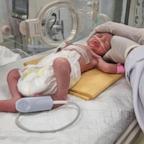Parents of Boy With Autism Map Out His Future as an Adult
As Tyler Bell grows too old for gov't support, family and friends step in.
PENNINGTON, N.J. Aug. 16, 2010— -- Tyler Bell starts his day just like anyone else: He brushes his teeth, takes a shower and makes breakfast. But because of his severe autism, the 17-year-old Bell needs help doing these simple tasks.
From the moment the alarm goes off at Tyler's Pennington, N.J. home, he relies on his mother, Liz Bell, to teach him the basics, step-by-step, using checklists to get him through the day.
"This is your to-do list for things that most of us don't need to do lists for, but he needs every day," said Liz Bell. One list, "Tyler's Shaving Routine," includes steps like "fill the sink with warm water" and "wet my face."
Watch "World News" for more on this story tonight on ABC.
Since Tyler was diagnosed at an early age, his parents have fought for him to receive help from educators and therapists through programs mostly paid for by the state. But there is a serious catch coming -- in four years, Tyler will turn 21 and the government support will end.
Very few resources exist for adults with autism, leading many of them to live life in isolation. The Bells want to avoid that fate for their son, but they worry what his future will be like when they're no longer there to offer support.
"I don't know a parent who doesn't go through that kind of emotional feeling of what happens if I go before my child does," said Peter Bell, Tyler's father and a senior official at Autism Speaks, the nation's largest autism advocacy group.
The Bells decided they needed to plan for the day when they are gone and Tyler will have to fend for himself. For two weekends, they gathered those in their community who were connected with Tyler -- neighbors, teachers and friends -- to map out his future, literally.
On a wall-sized piece of white butcher paper, the Bells graphically depicted where Tyler has been in his life and where he might end up, listing outcomes, both good and bad. The diagram outlined areas where Tyler needs the most help and what will happen to Tyler if he does or does not get that assistance.
A nightmare scenario on the map envisions a future in which Tyler is "alone," with "no friends," and subject to physical harm. But everyone in the room dedicated themselves to helping Tyler reach the most positive outcome.




